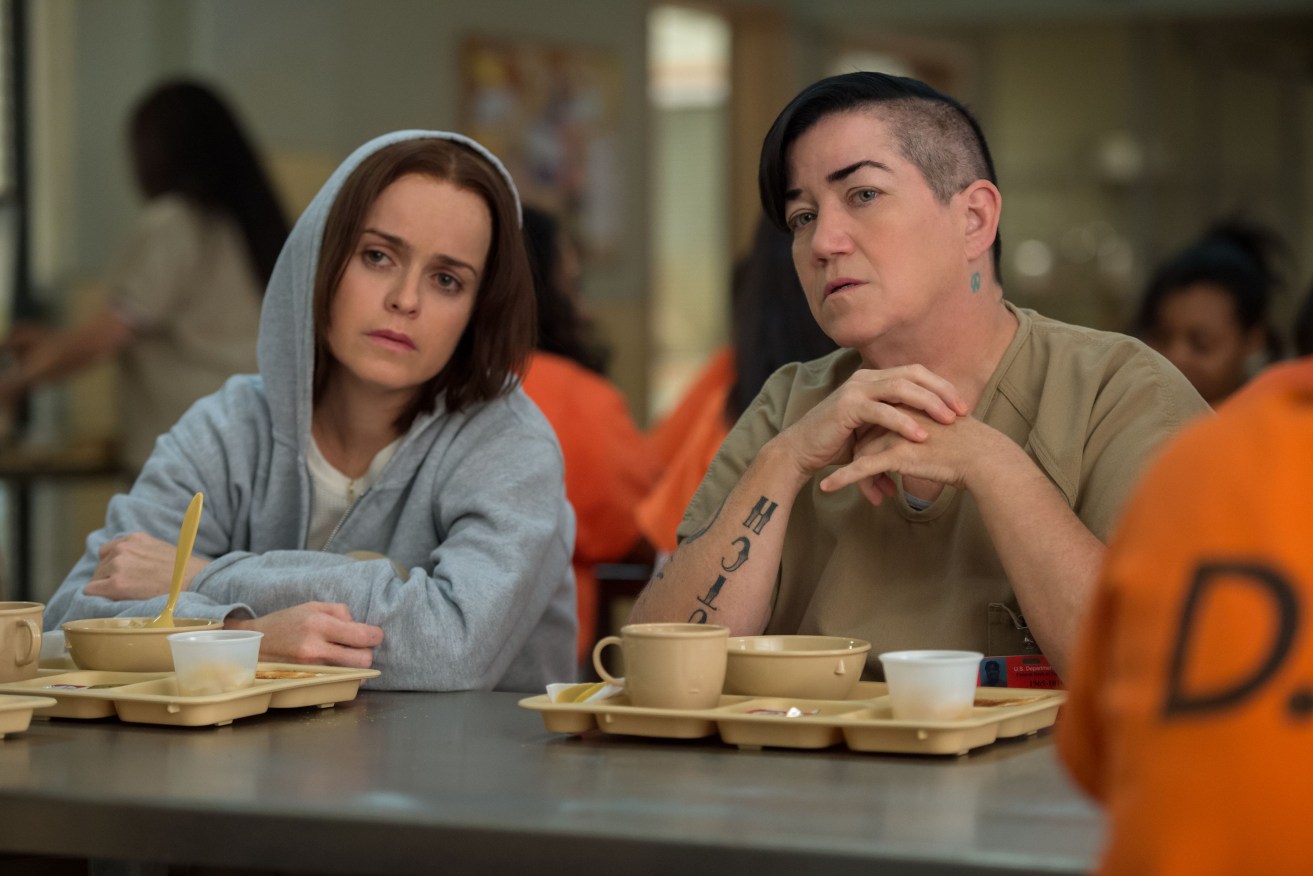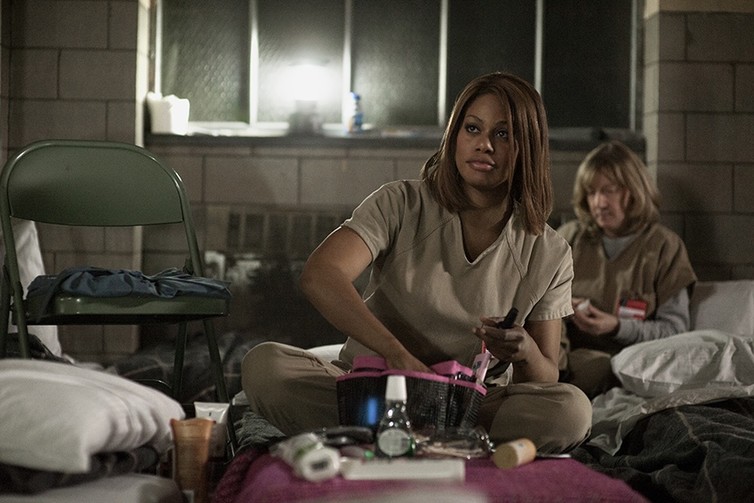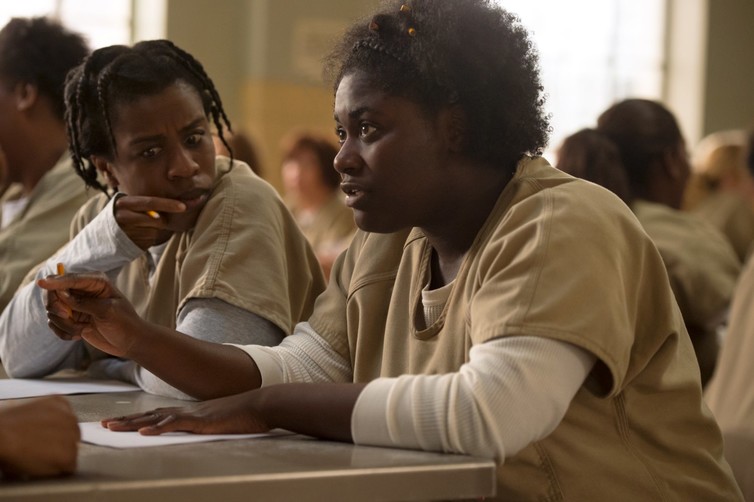How Orange is the New Black changed TV for the better
US prison drama ‘Orange is the New Black’ – now back with a fourth season – has broken new ground with its portrayal of women of all shapes, sizes, colours and sexual persuasions.

Big Boo (Lea DeLaria), right, and Tiffany ‘Pennsatucky’ Doggett (Taryn Manning). Photo: Tilted Productions/Lionsgate
The fourth season of Orange is the New Black returned on Friday. Unlike Netflix’s other blockbuster, House of Cards, the series did not have a well-known film director or any movie stars attached when it was released in June 2013. Yet despite its large ensemble cast of relatively unknown actors, it has become Netflix’s most watched and critically acclaimed original series.
Here are five ways the series has changed TV (for the better):
1: It gave us a plethora of varied female bodies
Orange is the New Black depicts a fabulously wide range of women – black, Latina, white, Asian, transgender, cisgender, old, young, skinny, fat, tattooed, pierced and scarred. All of these bodies are simultaneously powerful, transgressive, marginalised and desirable.
This plethora of women celebrated and displayed is itself a feminist act. Historically, US TV has tended to celebrate thin, white heterosexual female bodies: think Mary Tyler Moore, Ally McBeal and Carrie Bradshaw. When different bodies were depicted, their lack of physical desirability was presented as part of the joke. Think of Roseanne Barr or the criticism directed at Melissa McCarthy (described as “a female hippo” by one critic) over her weight.
Orange is the New Black dramatically expands the parameters of what kinds of bodies can and should take up space on US television.
https://www.youtube.com/watch?v=c6O9rfoz0f8
2: It presents so many queer characters in a matter-of-fact way
Queerness is depicted as a normal part of life at Litchfield prison. Queer characters include Piper Chapman (Taylor Schilling), Boo (Lea DeLaria), Alex (Laura Prepon), Nicky (Natasha Lyonne), Poussey (Samira Wiley), Suzanne (Uzo Aduba) and Brook (Kimiko Glenn), among many others. Each exhibits their sexuality in a unique way.
Boo has “BUTCH” tattooed on her forearm and in a flashback we learn that she has fought for the right to be identified this way. Boo’s angry – and not entirely likeable at all times – but she’s consistently engaging and surprising.
Another flashback scene shows us how the prison hairdresser, Sophia (Laverne Cox) – a transgender woman – committed credit card fraud to pay for her transition. In earlier US television series, transgender characters were largely used as a spectacle, as subjects of derision or humour or as a way to teach the protagonist a lesson.

In contrast, Sophia is quickly established as a complex and sympathetic character. Significantly, she is a transgender actor playing a transgender character – a rarity in American TV.
3: It privileges marginalised voices
Orange is the New Black consistently privileges the voices of often-marginalised women over that of its protagonist Piper Chapman (Taylor Schilling), a blonde middle-class woman who once lived “in a good-sized house” with a housekeeper, now sentenced to 15 months in jail on drug charges.
Over the first three seasons, Piper has become less central to the series’ narrative and politics. Indeed, as the embodiment of white privilege, she has come to represent the systemic racial and economic inequalities that led to the incarceration of many of her cellmates.
In the second season, for instance, Piper is granted furlough [prison leave] to visit her dying grandmother. Throughout the episode, various inmates tell Piper of the many times they applied for furlough – for reasons such as dying parents, the birth of grandchildren and a husband’s open-heart surgery – but were rejected. In doing so, they show how arbitrary and unfair the granting of her leave was.
4: It gives us in-depth stories of women of colour
Orange is the New Black is not creating a new world, but it is reflecting the diverse world in which it was created. As creator Jenji Kohan said in Sydney recently:
We’re presenting what’s out there and what’s real. What has been presented before isn’t normal.
One of the most engaging stories of the series, I would argue, is that of Tasha “Taystee” Jefferson (Danielle Brooks) – a young African-American woman who grew up “in the system”. Taystee was raised in foster homes before finding a “home” with her drug-dealing mother figure Vee (Lorraine Toussaint). Incarcerated due to crimes of poverty, Taystee is a force to be reckoned with. She is funny, intelligent, ambitious, bold and a loyal and fierce friend to Poussey.

Poussey and Taystee have jokey white-girl alter egos – Amanda and Mackenzie – which they use to articulate and satirise the difference between “white people politics” and “black people politics.” They ridicule sushi, veganism, health-care reform, yoga and National Public Radio as the domain of wealthy, white and privileged women.
Even in an era where there are more than 400 original scripted television series produced for US networks, it is still rare to find nuanced (and hilarious) characters like this who also happen to be women of colour.
5: It has inspired a host of new female-centred shows
More female-centred, female-authored series are now being viewed as viable commercial opportunities. Recent examples include UnReal (2015-), The Girlfriend Experience (2016-), Jane the Virgin (2014-), Crazy Ex-Girlfriend (2015-) and The 100 (2014-).
The visibility of trans-activist Laverne Cox has charted a path for Jill Soloway’s critically acclaimed Transparent (available on Stan), which follows Maura Pfefferman (Jeffrey Tambor) an older transwoman.
The success of Orange is the New Black and its diverse ensemble cast also undoubtedly influenced the green lighting of ratings juggernaut and hip-hop melodrama Empire (2015-). Empire, a sprawling ensemble drama that depicts the Lyons, an African-American family musical dynasty, is the first US network television series in decades to feature an almost entirely African-American cast.
The influence of Orange is the New Black can also be seen in UnReal (2015-), Lifetime’s first foray into original TV series programming. UnReal follows two ethically compromised and ruthless TV producers behind the scenes of a Bachelor-style reality-TV series. Like Orange is the New Black, it features several deeply flawed female characters grappling with contemporary issues around gender, race and class.
Numerous reviews of the third series of Orange is the New Black have argued that it lacked the cohesive structure of the first two seasons and was nudging into melodrama.
While it’s by no means a perfect series, it’s truly remarkable in its willingness to spend time with female characters and invest in their stories.
Jessica Ford is an early career researcher in Television, Gender, Film and Media Studies, UNSW. This article was first published on The Conversation.




